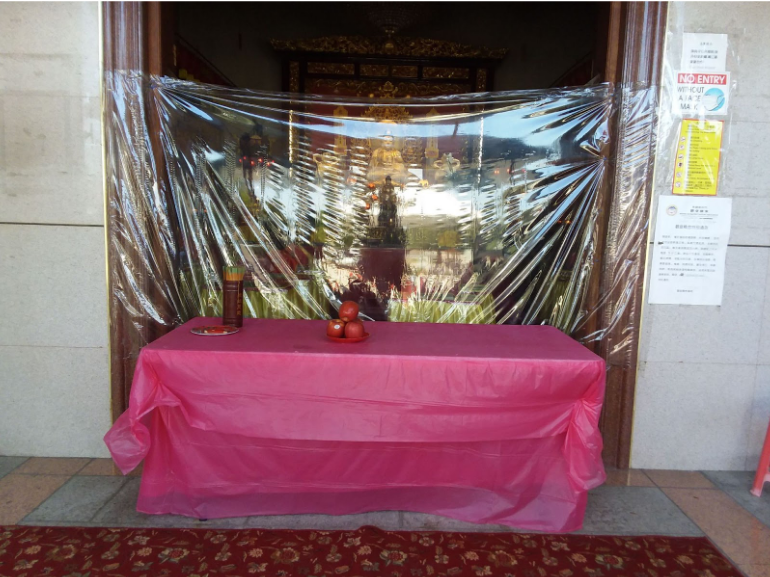
Teen Space, Antelope, California 2020
Chloe Low
This photograph is important to me because it is in the Teen Lounge of a public library that I went to often in high school. In those years, the area was always busy with teenagers from the local high schools studying together, using the computers to do homework, and to check out books and movies for both personal entertainment and for classes. I am struck by how this place that allows young adults to make the best of their education and for personal social development is now completely empty. While the sign says Teen Lounge, the area is taped off in six feet apart distances, and only one computer out of three can be in use. In the height of the pandemic, this photograph represents isolation and the loss of opportunity to grow professionally and socially. Also, it shows the importance of public spaces as resources for both technological and emotional support.

Open Hours, 2021, Los Angeles, California
Chloe Low
The sign on the right side says in Mandarin Chinese that the temple’s hours are limited, and no more than two people can enter at a time. I, and many others every day, must wait to go into the places we want to go. My mom and aunt were already inside. As I stood outside of the temple waiting for my turn to go in, someone walked up with a plastic plate stacked with apples. They placed it on the table cover in bright pink plastic and walked away. Standing there waiting to go into the temple, I realized the impact of having rules like “only two people inside at a time.” There is immense loss of community and belonging, making it so all someone can do is drop off a few apples in the middle of the day like that person did, or wait in line like me. Before, people would come to this temple to enjoy meals and pay respects to their loved ones who have passed away together. While people can see inside the temple through the plastic, it is still closed off. This experience is symbolic of the process of reopening as a continual negotiation of entering back into our communities; rather than return to the “old” normal, restrictions regarding social gathering reinforce a “new” normal.

Empty Streets, Chinatown, San Francisco, CA 2021
Cynthia Fok
Each night, the shop owners closed the gates to their businesses with the anticipation of opening it back up the next business day. Now, these shops are closed forever. What once was a street full of mom-and-pop stores and cafes filled with tourists and locals is empty. I asked a store owner of a herbal medicine store (not pictured) how the pandemic has affected their business. The store owner indicated that they were one of the more fortunate ones as the stores pictured above were forced to close down their business permanently. They indicated that these store owners anticipated re-opening their businesses once the spread of COVID-19 slowed down; unfortunately, this was not the case. Nonetheless, the shop owner that I talked to still expressed how business has been extremely slow compared to pre-pandemic times; however, they are grateful for the little amount of customers that come by every now and then.
As I waited for my parents to finish up in the store, I noticed police cars patrolling the street that this picture was taken. According to the store owner, due to the xenophobic nature of the COVID-19 pandemic, there has been an increase in police presence to ensure the safety of the remaining stores. Although this photo depicts the closure of once prominents stores, there is more depth to what is happening behind the scenes and how that has impacted the community.
This image represents the aftermath of many Asian businesses across the nation, and overseas. The xenophobic and racist connotation to the pandemic has significantly impacted Asian community, which is shown through this image as well as the spoken word of many Asian businesses owners. Due to the racist rhetoric of the pandemic, many people have avoided Asian-owned businesses, or attackers would vandalize stores causing financial and safety concerns for business owners. The closure of businesses has not only significantly changed their livelihood, but also their health and well-being. Therefore, on a larger scale, this image represents the change in individuals’ lives. Behind each gated store remains what was once a shop that nourished a family and community. Now, the street lays empty with remnants of what once represented our culture and our history.